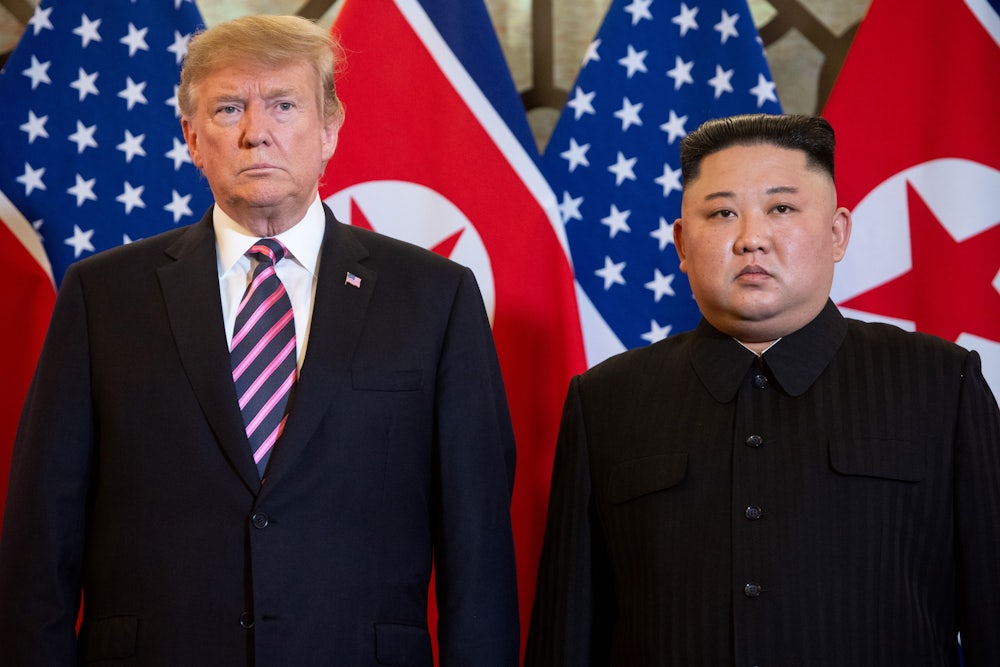The next crisis between the United States and North Korea is here. It began, as it always does, with Donald Trump’s and Kim Jong Un’s dueling egos, and it likely ends with Trump paying a price for his delusions of diplomatic grandeur.
Despite two top-level summits and the White House’s years-long insistence that Trump had thawed relations with Pyongyang like no other president could, Trump told reporters last week in London that U.S. military options remained on the table if Kim would not denuclearize. Kim “likes sending rockets up, doesn’t he?” Trump said. “That’s why I call him rocket man.” North Korean officials called Trump’s resumption of the rocket-man insult “the relapse of the dotage of a dotard,” then claimed over the weekend that they had conducted “a very important test” at a launchpad in the East Asian nation. Trump reacted to that news with tweeted threats, and North Korea responded by calling him, not incorrectly, a “heedless and erratic man.”
It’s all a far cry from the triumphant rhetoric a year and a half ago, when Trump and Kim held their historic Singapore summit, the first ever between leaders of North Korea and the U.S. Singapore appeared to walk both nations back from their “nuclear buttons.” Before, there had been talk of a U.S. limited strike on North Korea to give a nuclear-armed Kim a “bloody nose”; after, there was a bro-fest of love between the portly tyrant and the reality-TV president.
The language that found its way into the Singapore summit’s capstone declaration seemed promising—a vow to pursue “denuclearization” on the Korean peninsula somehow, at some point—but that had basically been promised before, in an empty 1993 U.S.-North Korea joint declaration. There were follow-up rounds of talks—all less successful than the initial Singapore fling—but no real progress was ever made.
The slow descent began for both Trump and Kim in Hanoi, Vietnam, where they held a deeply disappointing and abbreviated follow-up summit last February. There, the U.S. president discovered—as he told the world during the post-summit press conference—that it was the issue of sanctions relief that gummed up the works: “Basically, they wanted the sanctions lifted in their entirety, and we couldn’t do that.” For Kim, Hanoi was an embarrassment and a wake-up call. A few weeks later, he called on the U.S. to take a “bold decision” by essentially abandoning its all-or-nothing, denuclearization-first negotiating stance. If that were to happen by the end of 2019, he said, he’d be happy to meet Trump again for a third summit.
At the same time, Kim got his missile men back to work. Familiar faces to any watcher of the North Korean military—men like Jang Chang Ha and Jon Il Ho—began showing up again in state media. Soon enough, the missiles were flying again. Kim began his 2019 testing campaign on May 4; depending on how one chooses to count, this year has been the busiest ever in North Korean history, with some 26 unique missiles launched. Over the summer, North Korea also showed off a new ballistic missile submarine it was working on; then, of course, came last weekend’s “very important” test at the Sohae Satellite Launching Center, a facility that Kim had reportedly promised to dismantle in discussions with Trump at the Singapore summit.
North Koreans continue to reference the “end-of-year deadline,” but in reality, Kim has already charted a course away from the diplomatic negotiating table. The North Koreans are done talking to the Trump administration and are determined now to take a familiar, hard-line path, focusing on building up their nuclear program to seek leverage for the inevitable next round of negotiations with Washington—under a new president, perhaps.
After this weekend’s launchpad test, North Korea’s Academy of National Defense Science said that whatever was tested would benefit Pyongyang’s “strategic position.” North Korea may, in fact, be adding a new capability to its arsenal, one that could kick off a 2020 crisis in earnest. It would not be shocking, for instance, if we see a new solid-fuel-based intercontinental ballistic missile. (This would be a logical sequel to the large missiles North Korea tested in 2017.)
Ever averse to facts, Trump has built up a fiction of a disappearing North Korean threat, buttressed by his personal bromance with Kim. As insults begin to fly between him and the North Koreans, that facade is beginning to crumble. It’s not entirely Trump’s fault: After all, his secretary of state, Mike Pompeo, was a broken record throughout 2018—repeating, against all evidence to the contrary, that the Singapore agreement was an ironclad pledge for a “final, fully verified denuclearization of North Korea … as agreed by Chairman Kim.”
Kim’s signature on the Singapore pledge is there for everyone to see: He agreed to work “toward the complete denuclearization of the Korean Peninsula.” One might have hoped that Trump would figure out that, in the context of the Korean peninsula, “denuclearization” did not mean “disarmament.” He is instead doubling down on demands for the latter.
Given that fundamental misunderstanding, there’s no immediate off-ramp for escalating tensions going into 2020. Like clockwork, North Korean actions are stirring American reactions. Hawkish U.S. think tanks, such as the Foundation for the Defense of Democracies, are already excitedly circulating recommendations for a so-called “maximum pressure 2.0” campaign against North Korea. All of this portends a slow, steady lurch toward disaster. Trump and his deputies’ delusions about their prowess in “opening” North Korea have incurred tremendous debts to reality. As the new year approaches, those debts stand to be paid.
